21.8. - 5.9.2009
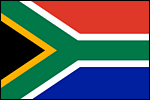 The end of the year 2008 moved more near and thus also the question, where I could spare my holiday.
I had traveled the last two years to destinations, for which I did not received (in good time) a radio license.
This time I wanted to play it safe.
The end of the year 2008 moved more near and thus also the question, where I could spare my holiday.
I had traveled the last two years to destinations, for which I did not received (in good time) a radio license.
This time I wanted to play it safe.
Thus I brought the CEPT list in agreement with my desire goals and the feasible tourist seasons.
The intersection lay in South Africa.
It is true, I was, there already once.
But in 1999 the tour goes from Cape Town always along the coast and then via the Kruger National Park to Johannesburg.
This time I target as destination the west coast and the north.
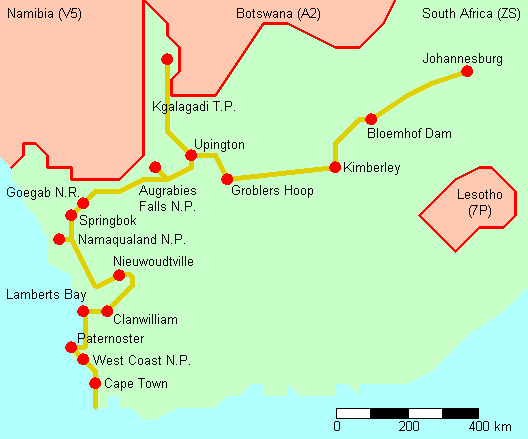 During my first journey across South Africa I used the Shongololo Express.
First I considered to use again this train, because it drives also from Capetown along the west coast to Namibia.
But then I would have seen nothing from the north.
During my first journey across South Africa I used the Shongololo Express.
First I considered to use again this train, because it drives also from Capetown along the west coast to Namibia.
But then I would have seen nothing from the north.
However Rotel Tours also drives along the west coast but then in the north head for Johannesburg.
Thus I booked this journey.
Probably it was more likely unusual for a journey, but I hoped it would rain a short time before.
Otherwise did not have to be seen.
The dry days ![]()
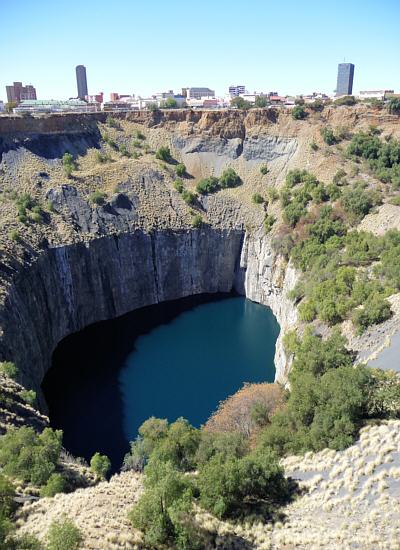
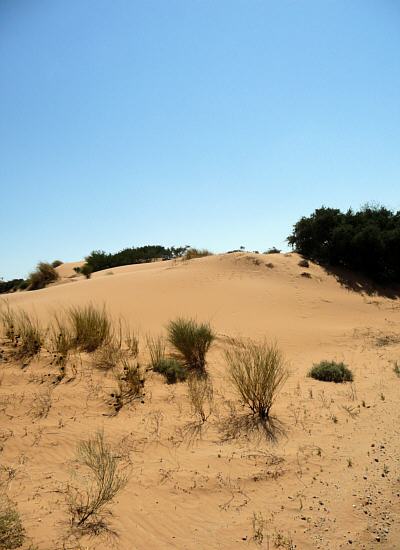 At the end of the day 1 we flight with a night flight to Johannesburg.
But this city was not our goal.
So we drove on directly toward to Bloemhof Dam.
That is a nature reservation at an artificial lake, on whose waterside our overnight acomondation was placed.
At the end of the day 1 we flight with a night flight to Johannesburg.
But this city was not our goal.
So we drove on directly toward to Bloemhof Dam.
That is a nature reservation at an artificial lake, on whose waterside our overnight acomondation was placed.
The day 3 guided us across Kimberley.
There are still the biggest ever by people created hole.
This old diamond mine fills slowly with water, but the still visible part is nevertheless impressing.
From 1871 to 1914 alltogether 22.5 million tons of rock were moved, in order to win diamonds with 14.5 million carat (2.9 tons) .
In the exhibition center you can see beside different geological presentations also within a particularly secured area genuine diamonds in all colors (yellow, green, blue, black).
In the evening we landed in Groblers Hoop.

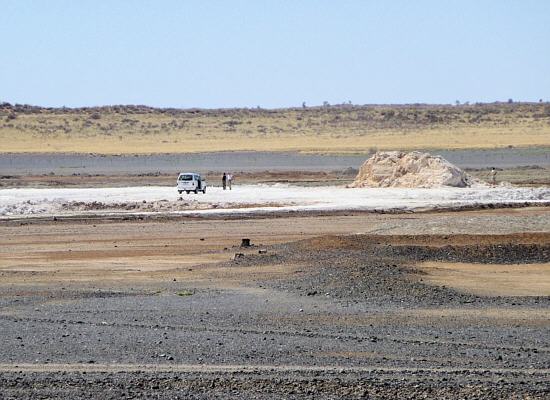 On the next day we drove along at the edge of the Kalahari desert.
It is a semi-desert, because it rains somewhat.
Thus there are some bushes and trees inside the dunes.
But the rain fills only rarely the flat sees with water.
In someone the left salt is marketed.
On the next day we drove along at the edge of the Kalahari desert.
It is a semi-desert, because it rains somewhat.
Thus there are some bushes and trees inside the dunes.
But the rain fills only rarely the flat sees with water.
In someone the left salt is marketed.
Particularly if no larger trees are present the telegraph poles are used by the sociable weaver as building site for its community nests.
In the eveneing we reached finally the Kgalagadi Transfrontier Park.
The animal-rich days ![]()
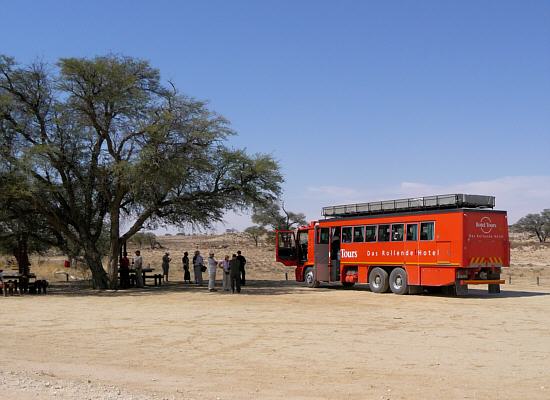
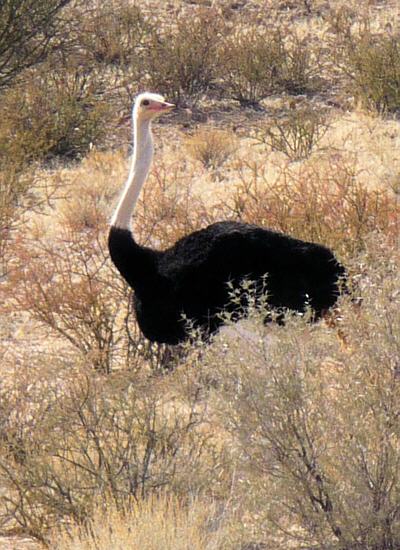 Without our sleeping trailer we continued to go on the next day to a small safari deeper inside the park.
Unfortunately we could not drive on long distance with our heavy vehicle.
Most ways are passable only for cross-country vehicles.
Our bu was an all-wheeled vehicle, but these distances remained locked for us..
Thus the by us driven area remained rather small compared with the large national park, which range far in the neighboring country Botswana.
Who want to see more, who should stay there for one or more overnight accommdations in the different camps in the park.
Without our sleeping trailer we continued to go on the next day to a small safari deeper inside the park.
Unfortunately we could not drive on long distance with our heavy vehicle.
Most ways are passable only for cross-country vehicles.
Our bu was an all-wheeled vehicle, but these distances remained locked for us..
Thus the by us driven area remained rather small compared with the large national park, which range far in the neighboring country Botswana.
Who want to see more, who should stay there for one or more overnight accommdations in the different camps in the park.
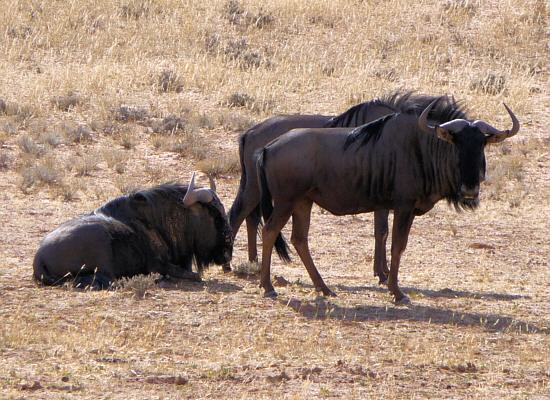
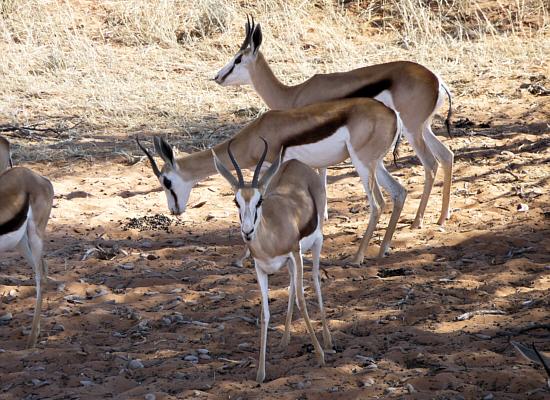 Nevertheless we could discover a lot of animals.
Ostrichs, blue wildebests, springboks and gemsboks were to constitute as large groups in larger distances, but also direct proximity.
They did not let themselves disturb also by our large and remarkable vehicle.
Probably this behavior also is owed by the fact that leaving of the vehicles is permitted only at the numerous earmarked rest places.
Nevertheless we could discover a lot of animals.
Ostrichs, blue wildebests, springboks and gemsboks were to constitute as large groups in larger distances, but also direct proximity.
They did not let themselves disturb also by our large and remarkable vehicle.
Probably this behavior also is owed by the fact that leaving of the vehicles is permitted only at the numerous earmarked rest places.
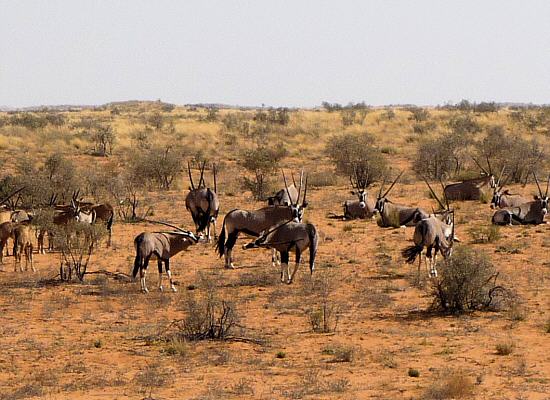
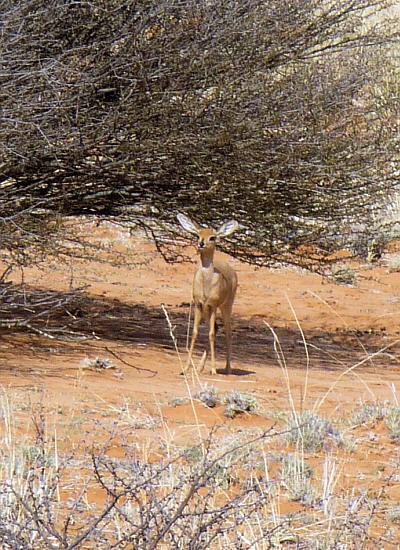 Also birds was to be discovers.
In a tree close of the way snoozed an owl.
Once we could pursue in direct proximity, as three smaller raptors dislodged a bigger representant of their kind.
Who was attentive, who could also observe suricates.
They guarded their lair, disappeared however when on our approach.
In addition rather shy natures like the small steenbok let themselves discover, disappeared however fast again.
Also birds was to be discovers.
In a tree close of the way snoozed an owl.
Once we could pursue in direct proximity, as three smaller raptors dislodged a bigger representant of their kind.
Who was attentive, who could also observe suricates.
They guarded their lair, disappeared however when on our approach.
In addition rather shy natures like the small steenbok let themselves discover, disappeared however fast again.
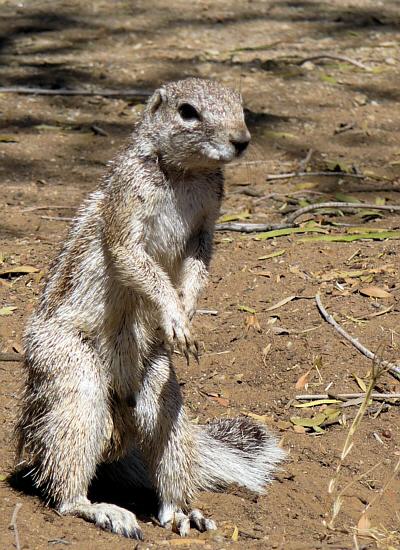
 Our goal of the day 6 was the Augrabies Falls Nationalpark.
In this park we undertook in the late afternoon still another small walk to the waterfall, since it's placed near the rest place.
Not only I "stumbled" over withal various rock dassies.
Unfortunately the weather was somewhat cloudy.
Our goal of the day 6 was the Augrabies Falls Nationalpark.
In this park we undertook in the late afternoon still another small walk to the waterfall, since it's placed near the rest place.
Not only I "stumbled" over withal various rock dassies.
Unfortunately the weather was somewhat cloudy.
Our female tourist guide guided us by glistening sun light at the next day around the closer environment of the water fall.
While our group moved over bizarre rock formations and across shallow rivers, we were observed of baboons from safe distances.
Ground squirrels and (larcenous) blue monkies gave it to see from next promiximity after the return to the rest place.
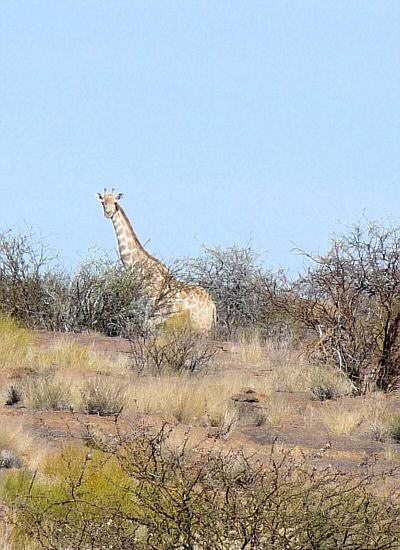
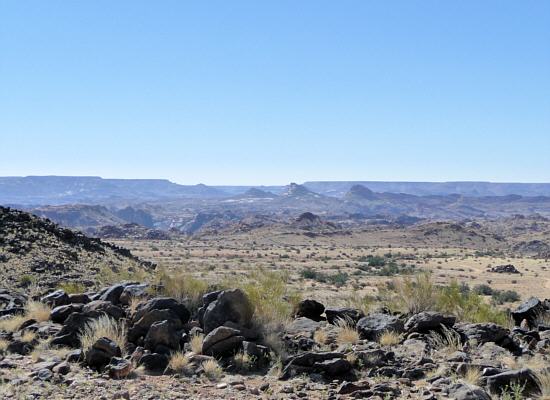 In the afternoon we could undertake another small safari tour in a small open car.
The bus by Rotel remained on the rest place.
This time we went into the further environment of the waterfall.
A goal still was to discover a few large animals of this area.
But we had to content us with a pair of Giraffes.
But instead of at least me compensated the bizarre rock landscape.
In the afternoon we could undertake another small safari tour in a small open car.
The bus by Rotel remained on the rest place.
This time we went into the further environment of the waterfall.
A goal still was to discover a few large animals of this area.
But we had to content us with a pair of Giraffes.
But instead of at least me compensated the bizarre rock landscape.
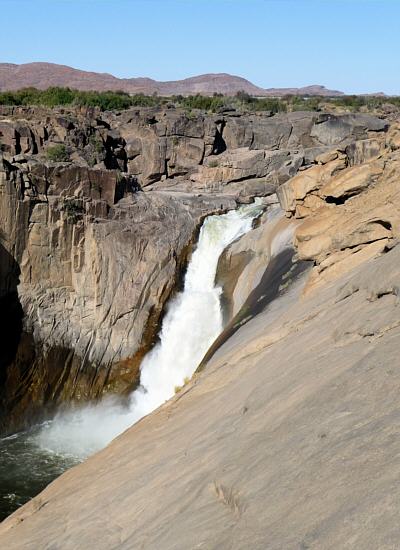
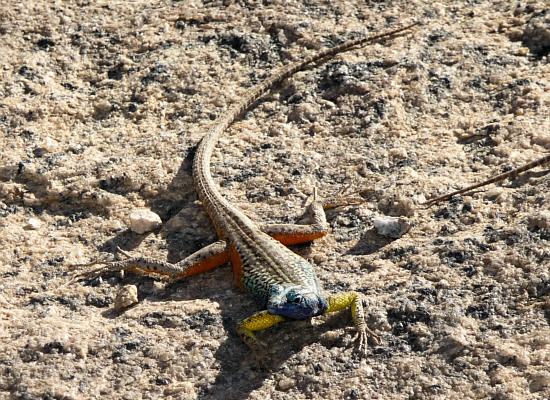 The leopards, caracals and jackals likewise resident in the park was not to catch sight.
The sunshine was also present after our return, so that a second walk to the waterfall was worthwhile.
Now the waterfall was in its whole splendour, at one place even with a rainbow.
Around the waterfall also various agama let itself look on the rocks.
The leopards, caracals and jackals likewise resident in the park was not to catch sight.
The sunshine was also present after our return, so that a second walk to the waterfall was worthwhile.
Now the waterfall was in its whole splendour, at one place even with a rainbow.
Around the waterfall also various agama let itself look on the rocks.
The flower days ![]()
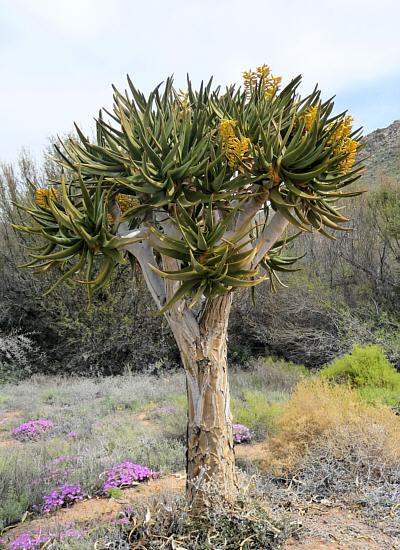
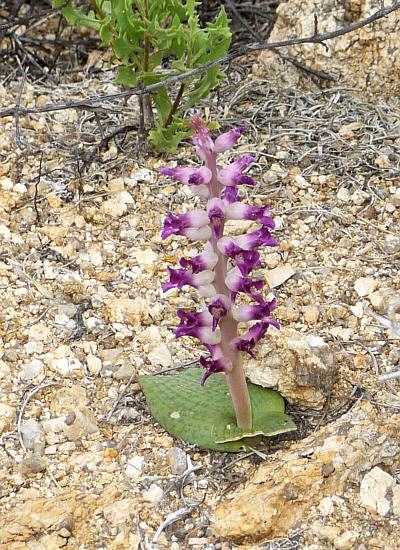 If the past days were located mainly in the indication of the animals observation, we approched on the day 8 the main goal: the flowers in the desert.
A very good opportunity to be able to admire the flora was offered in the Goegab Nature Reservation in the near of the city Springbok.
Several round ways lead there across the rocky mountain landscape.
Please does not ask me any longer for all the plant names, which said us our guide Elke.
In order to notice them all, there was simply to many.
It gives in this area over 4000 different species!
If the past days were located mainly in the indication of the animals observation, we approched on the day 8 the main goal: the flowers in the desert.
A very good opportunity to be able to admire the flora was offered in the Goegab Nature Reservation in the near of the city Springbok.
Several round ways lead there across the rocky mountain landscape.
Please does not ask me any longer for all the plant names, which said us our guide Elke.
In order to notice them all, there was simply to many.
It gives in this area over 4000 different species!
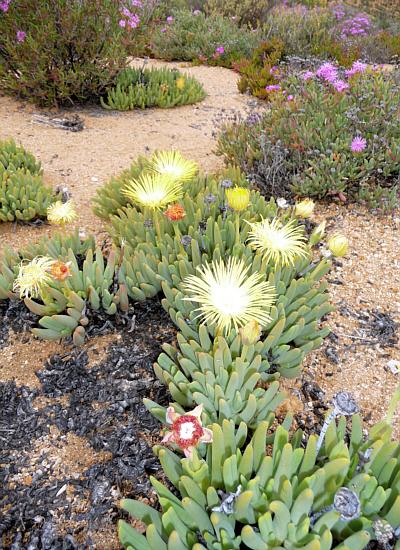
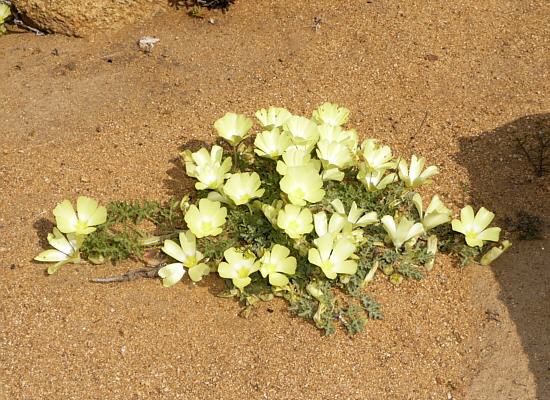 All plants in this area count to the category of the tropical flora.
The color spectacle is dependent on the rain.
A long-range forecast for emerging the flower sea is therefore difficultly.
But we had luck.
Who moved once by this flower carpet, who may not believe that this flower splendour have yielded in a few weeks again a drab red-grey sandy soil.
Than only a few bushes will be remained.
Of the flowers remain then only hundred tousends seed caps per square meter, wich waits on the rain of the comming year.
All plants in this area count to the category of the tropical flora.
The color spectacle is dependent on the rain.
A long-range forecast for emerging the flower sea is therefore difficultly.
But we had luck.
Who moved once by this flower carpet, who may not believe that this flower splendour have yielded in a few weeks again a drab red-grey sandy soil.
Than only a few bushes will be remained.
Of the flowers remain then only hundred tousends seed caps per square meter, wich waits on the rain of the comming year.
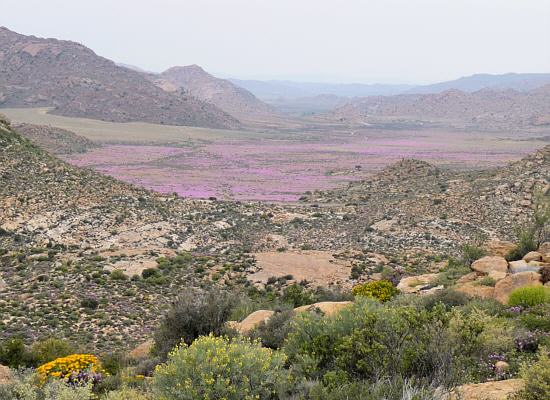
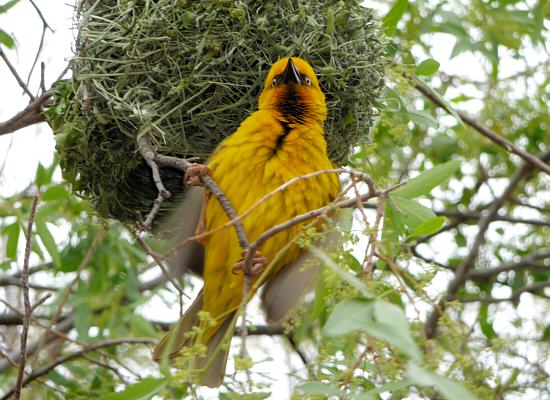 But where plants are to be seen, at least also always bird.
Here for example one of the many masked-weaver turned out for my camera.
They nestled in the garden of the small cafe, on whose parking lot our bus stood, and kick up a giant row.
The goal at the evening was the city Springbok, the center of the Namaqualand.
But where plants are to be seen, at least also always bird.
Here for example one of the many masked-weaver turned out for my camera.
They nestled in the garden of the small cafe, on whose parking lot our bus stood, and kick up a giant row.
The goal at the evening was the city Springbok, the center of the Namaqualand.
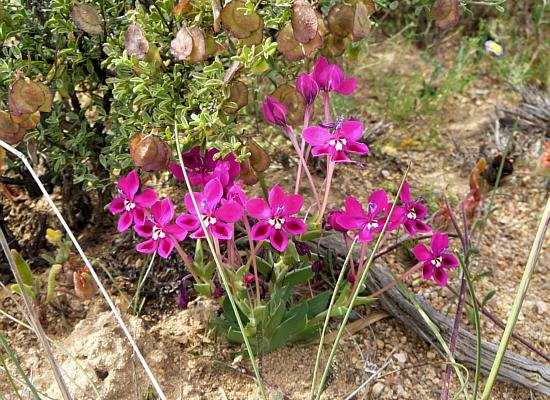
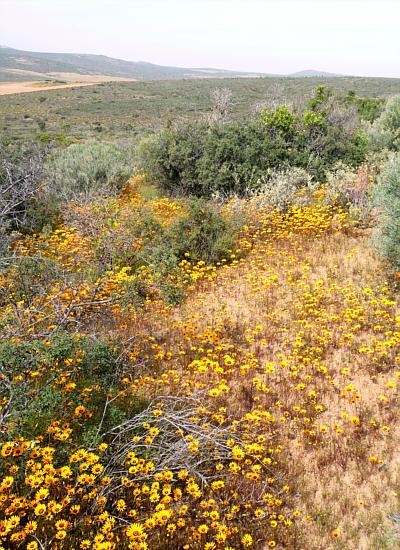 But the flower splendour should find still another increase at the day 9, when we went from Springbok for a one-day trip into the Namaqualand National Park.
Already during the trip there, we discovered the flower cushions in all colors, which can be found ever more frequently.
Of pink over yellow to orange let themselves violet constitute all variants.
Also many white and a few blue marks were to seen already by driving.
But the flower splendour should find still another increase at the day 9, when we went from Springbok for a one-day trip into the Namaqualand National Park.
Already during the trip there, we discovered the flower cushions in all colors, which can be found ever more frequently.
Of pink over yellow to orange let themselves violet constitute all variants.
Also many white and a few blue marks were to seen already by driving.
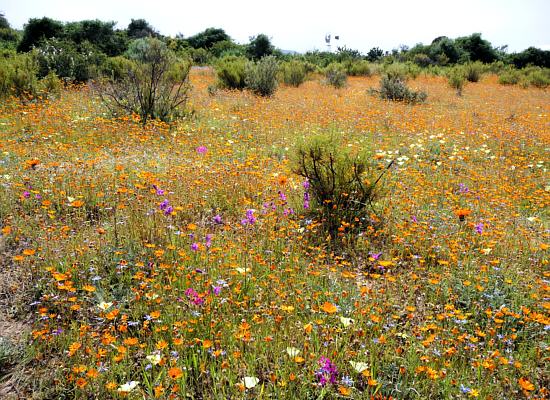
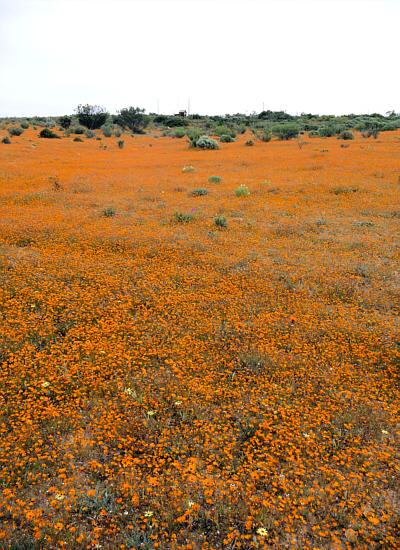 As we finally arrived at the Skilpad Game Flower Reserve (part of the Namaqua National Park), we trusted our eyes hardly.
The main color was a full orange.
I knew such a color splendour so far only of the flowering rape fields in Germany.
But with exact view it turned out fast, that is was not only a single sort of flowers.
It was rather a wild accumulation of different species, with which only the color orange outweighed.
There was just as often completely multicolored surfaces in nuances of yellow, red and blue.
As we finally arrived at the Skilpad Game Flower Reserve (part of the Namaqua National Park), we trusted our eyes hardly.
The main color was a full orange.
I knew such a color splendour so far only of the flowering rape fields in Germany.
But with exact view it turned out fast, that is was not only a single sort of flowers.
It was rather a wild accumulation of different species, with which only the color orange outweighed.
There was just as often completely multicolored surfaces in nuances of yellow, red and blue.
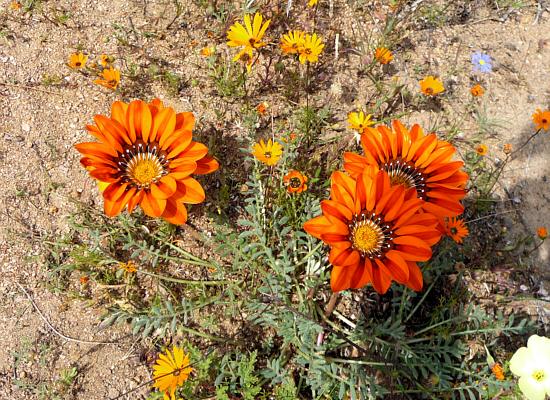
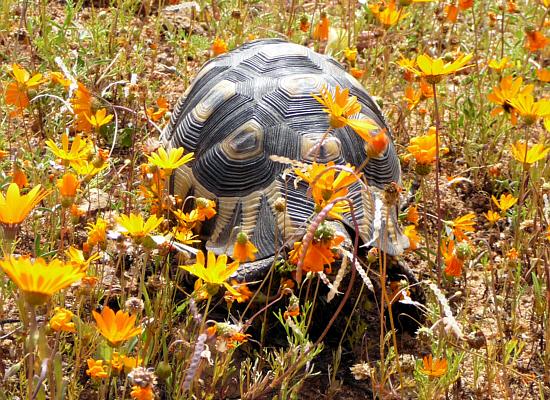 At least I did not come out from being astonished.
There the domestic, so preserved garden on the balcony faded completely.
At least I did not come out from being astonished.
There the domestic, so preserved garden on the balcony faded completely.
This area earned the name Skilpad not in vain, showed up during a second small tour.
On it one of the turtles, which can be found here repeatedly, running with an amazing speed over our way.

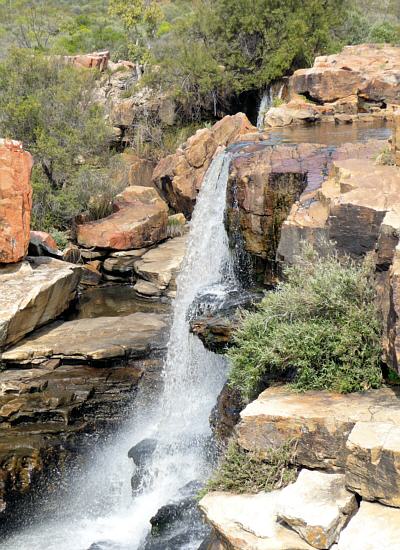 The day 10 led us across the Vanrhyns Pass to the Bokkefeld named high plateau.
Only with a view back it is to recognized, how extensive this country is.
There roads drag on 20 or 30 km dead-straight, before they discover a larger locality.
The day 10 led us across the Vanrhyns Pass to the Bokkefeld named high plateau.
Only with a view back it is to recognized, how extensive this country is.
There roads drag on 20 or 30 km dead-straight, before they discover a larger locality.
Our way went past to the 90 m high Nieuwoudtville Waterfall, close of the small city with the same name.
Although in September the rain time is over and thus less water was present in the river, an excursion there is even worthwhile.
There are, in addition to the beautiful landscape, also adequate flowers to see.
And the rancher of this area offering (at the weekends) self-made jam and sausages.

 On the way to our rast place on a cheep farm it went over dirt roads.
We could discover a larger accumulation of blue cranes.
These birds gracing among others the coat of arms of South Africa.
On the way to our rast place on a cheep farm it went over dirt roads.
We could discover a larger accumulation of blue cranes.
These birds gracing among others the coat of arms of South Africa.
In the early afternoon we arrived on the farm.
The majority of the traveler group uses the opportunity to drive with the bus over the fields dotted with flowers now - of course on the proven ways.
But I walked together with some other enthusiasts to foot around.

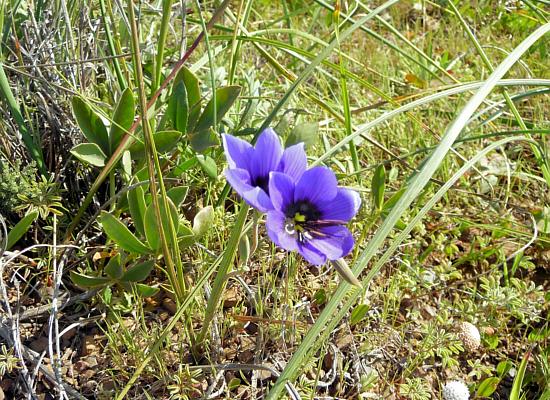 The main attraction of this area are not only for botanists the various bulbous plants.
Of them we could discover also various species, which captivated by all possible colors and shapes.
Between are miscellaneous orchids.
I remember me particularly at the bulbinella, a yellow flower, whose looked for me nearly like a starting rocket on New Year's Eve.
This flower prosper also in white and red, but we could sight only the yellow one.
The main attraction of this area are not only for botanists the various bulbous plants.
Of them we could discover also various species, which captivated by all possible colors and shapes.
Between are miscellaneous orchids.
I remember me particularly at the bulbinella, a yellow flower, whose looked for me nearly like a starting rocket on New Year's Eve.
This flower prosper also in white and red, but we could sight only the yellow one.
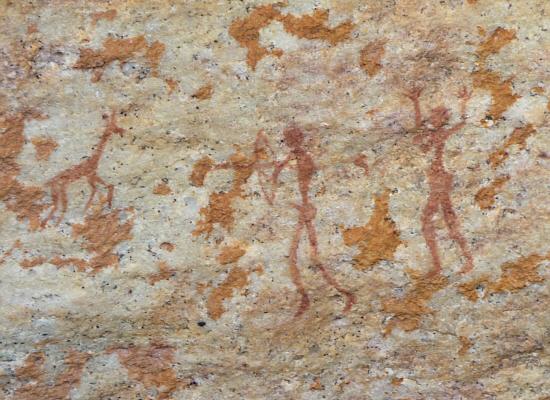
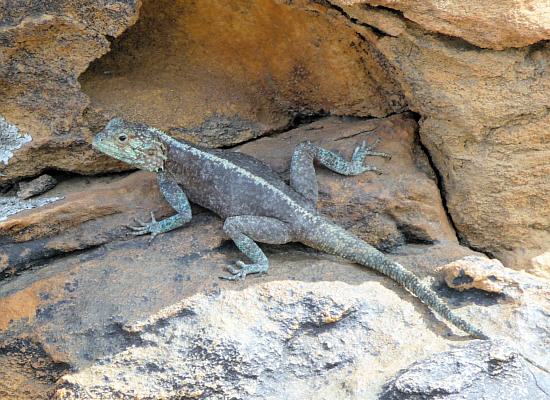 On the way to Clanwilliam we undertook another excursion to a valley, in which particularly many rock paintings could be found.
This Sevilla Trail mentioned area covers several ways.
We went only a short part on the short way.
Who wants insteed of taking a whistle-stop can here walk also several day-long on the way.
On the way to Clanwilliam we undertook another excursion to a valley, in which particularly many rock paintings could be found.
This Sevilla Trail mentioned area covers several ways.
We went only a short part on the short way.
Who wants insteed of taking a whistle-stop can here walk also several day-long on the way.

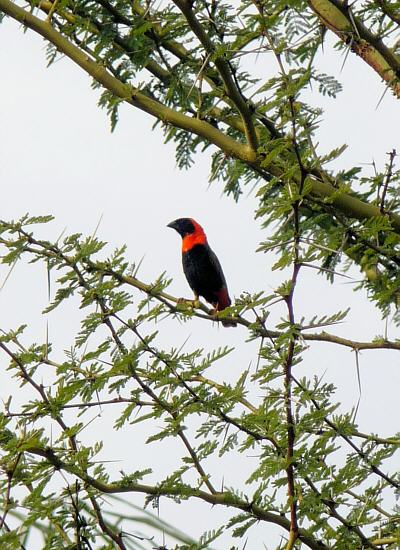 Clanwilliam is the center of the rooibos tea production of South Africa.
An exhibition center in the factory, in which the bushes serving as basis for the tea, can be visited.
But the factory buildings are not open for visiters.
The aromatic tea will be exported from there into the whole world.
Clanwilliam is the center of the rooibos tea production of South Africa.
An exhibition center in the factory, in which the bushes serving as basis for the tea, can be visited.
But the factory buildings are not open for visiters.
The aromatic tea will be exported from there into the whole world.
When I sat with some travel passenger in a cafe in the city, something glaring red flew by air.
Only as this fire ball established itself on a camel thorn tree, it was emerged as a red bishop.
The days at the ocean ![]()
 Now, since we came more to the water of the Atlantic, it did not surprise that we spy strengthens sea-birds.
In front of the coast of Lamberts Bay there is even a small colony of cape gannets (and somewhat further away of ear seals).
Their nestling places can be attained owing by foot to a small mole at the port.
A small observation tower facilities the observation of these beautifully colored birds.
Now and then also penguins are to appear themselves on the island.
When we were there, they did not let look itself however.
When adition a few dolphins was to watch, which cavorted in the bay.
Now, since we came more to the water of the Atlantic, it did not surprise that we spy strengthens sea-birds.
In front of the coast of Lamberts Bay there is even a small colony of cape gannets (and somewhat further away of ear seals).
Their nestling places can be attained owing by foot to a small mole at the port.
A small observation tower facilities the observation of these beautifully colored birds.
Now and then also penguins are to appear themselves on the island.
When we were there, they did not let look itself however.
When adition a few dolphins was to watch, which cavorted in the bay.

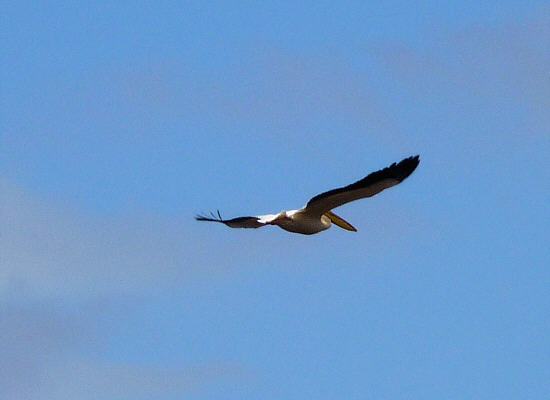 On the way from Lamberts Bay to Vredenburg Alfred, our driver, used the way at the beach, which lying parallel to the highway.
It is particularly not comfortably and from there only slowly to driven.
But from this way among other things flamingos was to seen.
Also a parallel to the road flying pelican I could capture with the camera.
After a short stop in Vredenburg we drove to Paternoster.
On the way from Lamberts Bay to Vredenburg Alfred, our driver, used the way at the beach, which lying parallel to the highway.
It is particularly not comfortably and from there only slowly to driven.
But from this way among other things flamingos was to seen.
Also a parallel to the road flying pelican I could capture with the camera.
After a short stop in Vredenburg we drove to Paternoster.
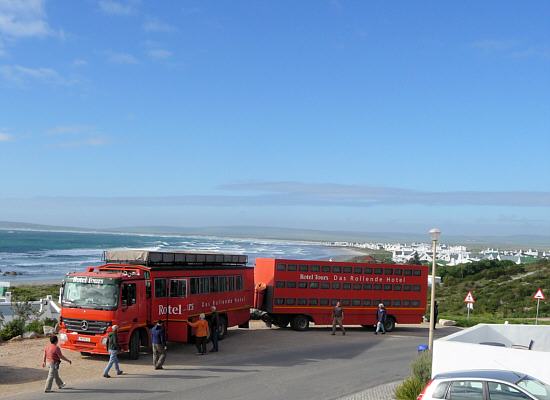
 Paternoster is a former small fishing village that changed itself to a contemplative resort.
We stayed overnight in the Cape Columbine Nature Reserve near Paternoster direct at the Atlantic.
There was no electrical power connection present, but sitting in the evening around a campfire we enjoyed the sea nevertheless.
Paternoster is a former small fishing village that changed itself to a contemplative resort.
We stayed overnight in the Cape Columbine Nature Reserve near Paternoster direct at the Atlantic.
There was no electrical power connection present, but sitting in the evening around a campfire we enjoyed the sea nevertheless.
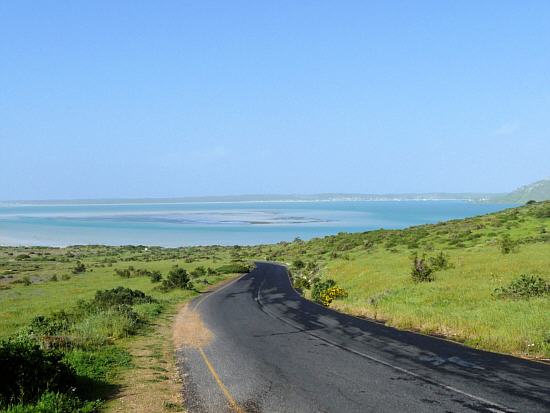
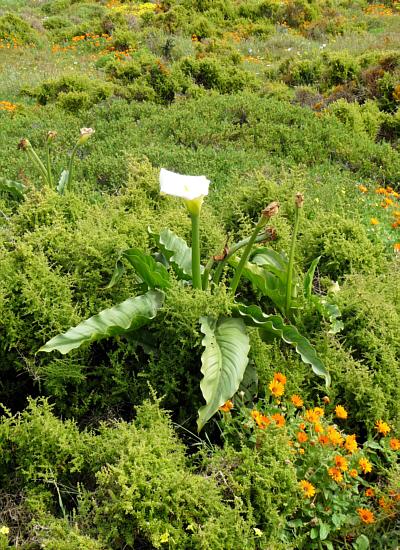 Around the Langebaan Lagoon (West Coast National Park), which we visited on the day 13, are located 150000 birds - probably a paradies for ornithologists.
In addition sufficient flowers as well as big and small animals were to discovered.
Around the Langebaan Lagoon (West Coast National Park), which we visited on the day 13, are located 150000 birds - probably a paradies for ornithologists.
In addition sufficient flowers as well as big and small animals were to discovered.
But the among other things close to the Atlantic observed Bonteboks hide themselve again fast, when our bus held and we sauntered to the beach.
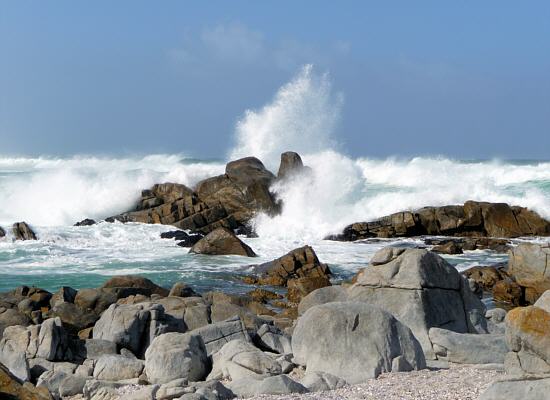
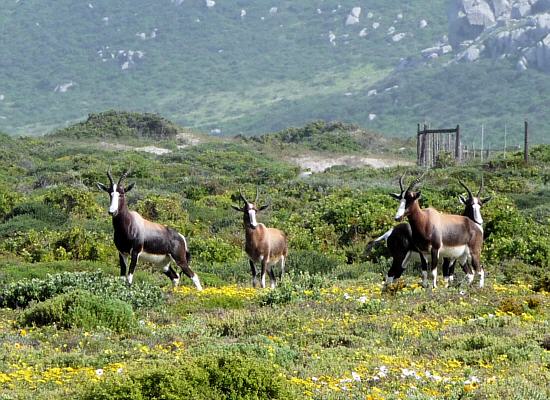 At the wonderful white sand beach was still sufficient time to walk.
To bathing in the water was however definitely too cold and the waves too strongly.
At the wonderful white sand beach was still sufficient time to walk.
To bathing in the water was however definitely too cold and the waves too strongly.
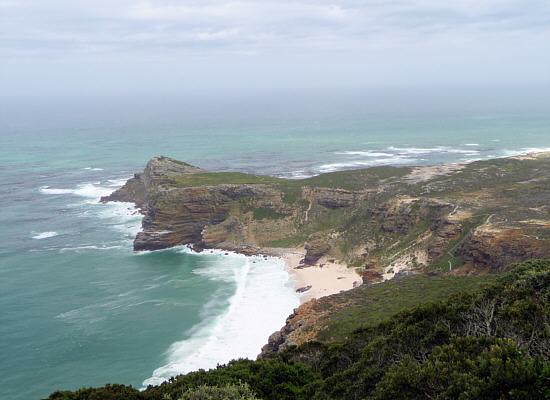
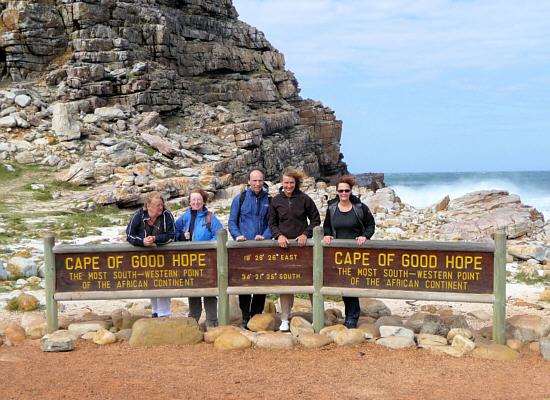 The day 14 was reserved for visiting the Cape Peninsula.
On the way into the south the Twelve Apostle (a mountain range at the table mountain) were not to see in the fog, but this got thinner soon.
When we finally arrived at the most south-western point of the African Continent, predominated beautifull sunshine.
Only the wind blew with substantial strengh.
But we defied, when it went in a small hike from Cape Point to the Cape of Good Hope.
The day 14 was reserved for visiting the Cape Peninsula.
On the way into the south the Twelve Apostle (a mountain range at the table mountain) were not to see in the fog, but this got thinner soon.
When we finally arrived at the most south-western point of the African Continent, predominated beautifull sunshine.
Only the wind blew with substantial strengh.
But we defied, when it went in a small hike from Cape Point to the Cape of Good Hope.
Note: The most southern point of the African Continent, and hence the point of concourse of the Atlantic and the Indian Ocean, are Cape Agulhas which lies 150 km more south-eastern.
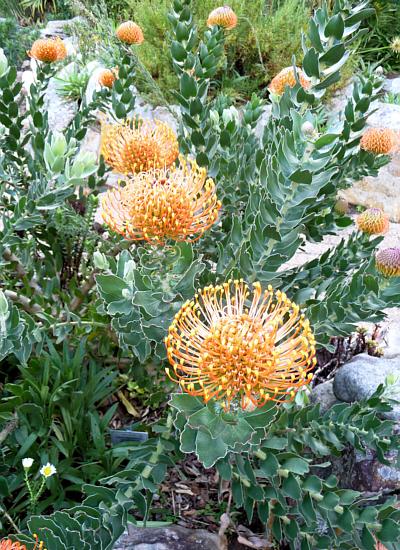
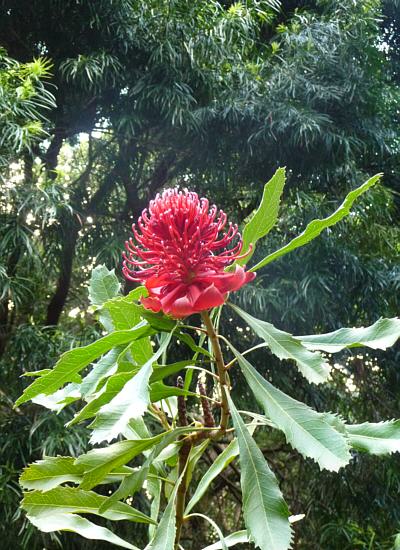 On the way back to our rast place far outside of Capetown we visited still the botanic garden of Kirstenbosch.
There many of the flowers we discovered so far in free game course were seen again from next proximity.
On the way back to our rast place far outside of Capetown we visited still the botanic garden of Kirstenbosch.
There many of the flowers we discovered so far in free game course were seen again from next proximity.
Also some species, which we had found only in the withered condition, were located here still in full-blown - so for example the various protea.
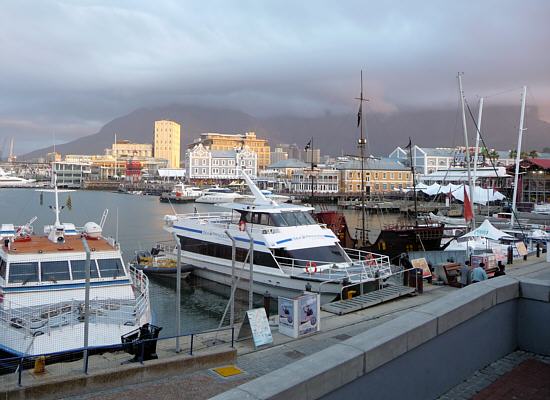
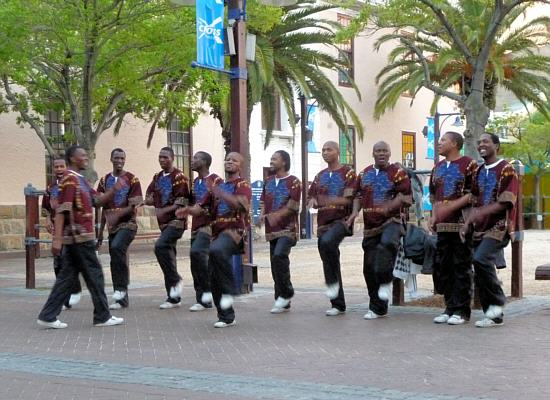 In the evening we sauntered then still briefly along the Waterfront of Capetown.
Into the former port halls are located today good restaurants and excellent shops, which also gladly visited by the inhabitians of Capetown themselve.
On the way to one of the fish restaurants a small part of our group could discover also the Abonwabisi Brothers.
They was inspired by the legendary choir Ladysmith Black Mambazo.
Who wants, a CD-ROM with its songs can acquire locally - a somethings else souvenir.
In the evening we sauntered then still briefly along the Waterfront of Capetown.
Into the former port halls are located today good restaurants and excellent shops, which also gladly visited by the inhabitians of Capetown themselve.
On the way to one of the fish restaurants a small part of our group could discover also the Abonwabisi Brothers.
They was inspired by the legendary choir Ladysmith Black Mambazo.
Who wants, a CD-ROM with its songs can acquire locally - a somethings else souvenir.
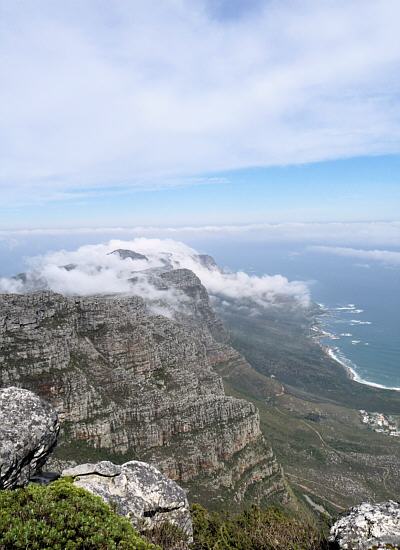
 There the weather on the day 15 while driving to Capetown changed from cloudy to sunny and also the wind did not blow so strong as the day before, it pulled all members on the Table Mountain.
The round tour there above remained short regarding the imminent return flight, but is was spectacular.
There the weather on the day 15 while driving to Capetown changed from cloudy to sunny and also the wind did not blow so strong as the day before, it pulled all members on the Table Mountain.
The round tour there above remained short regarding the imminent return flight, but is was spectacular.
Fortunately were all members of our group at the valley station, when the table cloth put over the Table Mountain.
At this time it descended with the lift neither up nor down - and those people, who still walk on the plateau, stuck above with icecold weather (due the clouds).
But for us it went to the airport, of where out we began our return flight with an inland flight to Johannesburg.
After a repeated night flight we landed again in Germany.
Guest license and amateur radio station ![]()
South Africa is a CEPT country.
Since Germany is likewise member of the CEPT, it means that I could be active up to three months without any formalities from there.
Necessary are only the own license.
As CW transceiver I have put the 4 band version of the Elecraft K1 in the luggage, which I have built up in January.
I refrained from this time the use of a monoband transceiver, because the conditions are firmless during the actual solar minimum.
One is determined with a monoband station to a single band - and this band can be not open, if one want to be on air.
As antenna I have put two 10 m wire, the ZM-4 and my 10 m long DK9SQ telescope mast in the luggage.
With this parts it should be able to errect various antennas: long-wire, invertet-V, Up & Outer, inverted-L and so on.
But in order.
Everything begins as well known with the stowing of the station away.
I used, as in the years before it, a small metal suit-case, which I packed into the locked traveling bag.
So far the German security agency (and only) got me after the dispatching again and again for a check back to the switch.
I showed them, what in the suit-case it is and the traveling bag began its journey provided with a small supporter again by the airport to the airplane.
Afterwards the luggage without further controls up to the goal airport arrived, even if this several flights one behind the other were.
But this time was everything different.
Already during the dispatching it noticed to me that I did not have to make the second course to the switch.
The reason for it I noticed only in South Africa: The traveling bag had been opened!
Since I had its zipper locked with a small padlock, one was not boggled from pulling out a large part of the zipper.
In the bag lies a notes confirmed the opening by the security in Germany.
On the note it was noted, that it was not possible due to the intensified security checks to unite the traveler and its luggage for additional control.
The insolence was, that two persons had signed on the note that by the search the luggage was not one damaged.
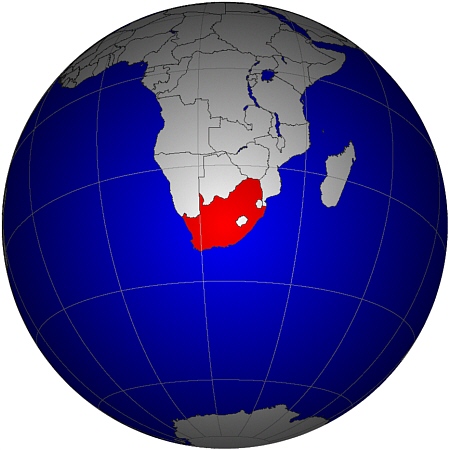 Still plentifully annoyed I developed my station in the first evening directly at the Bloemhof Dam.
On 18 and 15 m nothing (more) was to be heard.
Only on 30 and 40 m I could hear some stations.
But success did not want to adjust itself.
The stations stopped briefly with their CQ-calls, but not yet times a further inquiry was to be heard.
Only the new CQ-calls confirmed me, that my signal must have been too thin.
Still plentifully annoyed I developed my station in the first evening directly at the Bloemhof Dam.
On 18 and 15 m nothing (more) was to be heard.
Only on 30 and 40 m I could hear some stations.
But success did not want to adjust itself.
The stations stopped briefly with their CQ-calls, but not yet times a further inquiry was to be heard.
Only the new CQ-calls confirmed me, that my signal must have been too thin.
Also the second and third attempt in the Transfrontier Park did not bring QSO's in the logbook.
I heard again some stations from Europe (Italy, Germany, Russia) and even a station from Indonesia.
I called it immediately, but connections did not come off again.
Thus the energy shrank fast.
My last hope were always the QRP frequencies.
Unfortunately no signals were to be hear there.
And in such a way it did not surprise also that also on various CQ-calls nobody answered there.
After three evenings, on which I sat altogether 12 hours unsuccessful at the station, I gave up in the long run.
The station remained packed up for the remainder of the journey.
Only the Spieth mast carried out still as valuable help for me when chasing away the larcenous monkies.
Certainly they had not seen such a long snake yet in their trees.
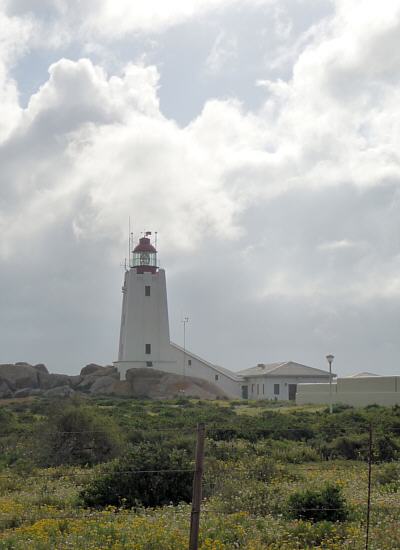 On our way to the rast place near Paternoster we went past also at the lighthouse at Cape Columbine (SAF-034).
In the internet I found the information that this is the last manned lighthouse in South Africa.
But this statement is wrong, as our guide Elke said to me.
At least at the lighthouse on Dassen Island (SAF-042) live still some persons.
And she should know it, because this island lies directly before their entry door.
When I was again at home, I could find this confirmed after some search also in the internet.
Probably it gives even still more than these two lighthouses, on which in South Africa guards do their service.
On our way to the rast place near Paternoster we went past also at the lighthouse at Cape Columbine (SAF-034).
In the internet I found the information that this is the last manned lighthouse in South Africa.
But this statement is wrong, as our guide Elke said to me.
At least at the lighthouse on Dassen Island (SAF-042) live still some persons.
And she should know it, because this island lies directly before their entry door.
When I was again at home, I could find this confirmed after some search also in the internet.
Probably it gives even still more than these two lighthouses, on which in South Africa guards do their service.
Result: It is difficulty to want to reach in the sunspot minimum with a QRP station DX-connections.
Sometimes it, as with me, can fail completely.
But I am not therefore annoyed.
On me did not rest the success printing of a DXpedition.
And I had not also arranged skeds in wise foresight.
It would have been a nice occupation in the evenings, but I had very pleasantly spent it also in such a way (with a good red wine and in the discussion with the other travelers).
After my return to Germany I turned immediately to the place of the airport, which assumes themselves missed and damaged luggage items.
There understood one my annoyance, but I would have had to refund at the latest 7 days after the damage message.
So that they not lose me as customer, we were suitable on the fact that the damage had happened not with the outward flight, but (straight only) with the return flight.
Thus I could give up nevertheless still another notice of damage and received new other traveling bag.
Again something learned: Even if you want to be with a small radio station on the way, then stow the equipment in the suitcase and leave the suitcase open.
Alternativ you can stow the station in the hand luggage.
But then you must present it with each airplane change.
So, that were my experiences in South Africa in short form.
I do not reach as ZS/DK3RED other hams, but the journey was nevertheless a disaster.
For it the country was not least simply too interesting with its flora and fauna and with its inhabitants.
73/72 de Ingo, DK3RED - Don't forget: the fun is the power!